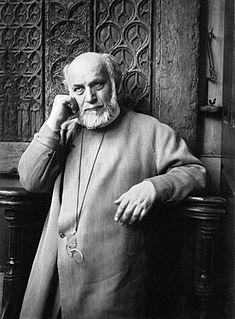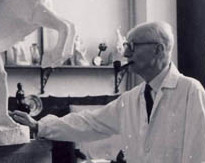
François Auguste René Rodin was a French sculptor, generally considered the founder of modern sculpture. He was schooled traditionally and took a craftsman-like approach to his work. Rodin possessed a unique ability to model a complex, turbulent, and deeply pocketed surface in clay. He is known for such sculptures as The Thinker, Monument to Balzac, The Kiss, The Burghers of Calais, and The Gates of Hell.

Antoine Bourdelle, born Émile Antoine Bordelles, was an influential and prolific French sculptor and teacher. He was a student of Auguste Rodin, a teacher of Giacometti and Henri Matisse, and an important figure in the Art Deco movement and the transition from the Beaux-Arts style to modern sculpture.

The Thinker is a bronze sculpture by Auguste Rodin, usually placed on a stone pedestal. The work depicts a nude male figure of heroic size sitting on a rock. He is seen leaning over, his right elbow placed on his left thigh, holding the weight of his chin on the back of his right hand. The pose is one of deep thought and contemplation, and the statue is often used as an image to represent philosophy.

The Burghers of Calais is a sculpture by Auguste Rodin in twelve original castings and numerous copies. It commemorates an event during the Hundred Years' War, when Calais, a French port on the English Channel, surrendered to the English after an eleven-month siege. The city commissioned Rodin to create the sculpture in 1884 and the work was completed in 1889.
Marcel Antoine Gimond (1894–1961) was a French sculptor known for his busts, statues, and portraits in bronze.

Ion Jalea was a Romanian sculptor, medallist, titular member of the Romanian Academy.

The Musée Ingres is located in Montauban, France. It houses a collection of artworks and artifacts related to Jean Auguste Dominique Ingres, and works by another famous native of Montauban, Antoine Bourdelle.

The Musée Bourdelle is an art museum located at 18, rue Antoine Bourdelle, in the 15th arrondissement of Paris, France, located in the old studio of French sculptor Antoine Bourdelle (1861–1929). The museum is open daily, except Mondays. Admission to the permanent collections is free. The nearest metro stations are Falguière and Montparnasse-Bienvenüe.

Hercules the Archer is a sculpture by Antoine Bourdelle, originally made in 1909, which now exists in many versions. It was a commission of the financier and philanthropist Gabriel Thomas, as a single copy in gilt-bronze in April 1909; Bourdelle worked on the sculpture in the summer of 1909. It was cast by Eugène Rudier, and it was exhibited at the National Society of Fine Arts in 1910, and much appreciated. The dimensions were 2.50 m × 2.40 m.

The Monument aux Morts de Montauban is an 1894 sculpture by Antoine Bourdelle. His romantic vision of the monument generated many violent oppositions. Auguste Rodin's intervention in 1897 enabled Bourdelle to do this sculpture without any compromise. The monument was erected in Montauban, in the department of Tarn-et-Garonne, in 1902.
Louis Dejean, was a French sculptor and engraver. He worked in the workshop of Gaston Schnegg, along with Antoine Bourdelle, Charles Despiau, Robert Wlérick, Léon-Ernest Drivier, François Pompon, Alfred Jean Halou, Charles Malfray, Auguste de Niederhausern, Henry Arnold, Jane Poupelet and Yvonne Serruys.
Charles Malfray was a French sculptor.
Angela Gregory was an American sculptor and professor of art. Gregory has been called the, "doyenne of Louisiana sculpture". She became one of the few women of her era to be recognized nationally in a field generally dominated by men.
Eustațiu Stoenescu was a Romanian painter principally known for his portraiture. Eustatiu Stoenescu family originated from Oltenia in Romania. His father was a senator and his mother Mathilda was born in Brittany. Stoenescu met the French painter Leopold Durangel in 1889. He moved to Paris in 1900, with his friend Nicolas Titulescu. Stoenescu was, early on, inspired by the work of Jean-Paul Laurens with whom he studied. His first exhibition took place in 1905 at the Salon officiel de Paris and the same year in Craiova. He was immediately successful and had the opportunity to meet prestigious artists such as Auguste Rodin, Antoine Bourdelle, Henri Harpignies and Charles Cottet. By 1930 he was considered in French art circles to be the greatest living Romanian painter at the time. He was great portraitist not only capable of showing physical resemblance of the model but also the psychological dimension. He went many times in Brittany where he painted landscapes especially in Loctudy. He was a friend of the sculptor Constantin Brâncuși, who made a (lost) portrait bust of Stoenescu's son Daniel Eustațiu Stoenescu. Daniel went on to become a successful, Coty Award winning designer of inventive costume jewellery who, with Steven Brody, founded the Cadoro jewelry company in Manhattan.

Margaret Cossaceanu, born Margareta Cosăceanu, later Margaret Cossaceanu-Lavrillier was a French sculptor of Romanian origin.

The Bust of Victor Hugo is an 1883 patinated plaster sculpture by the French artist Auguste Rodin of the Romantic writer Victor Hugo. It is now in the Museo Soumaya in Mexico City.

The Bust of Auguste Rodin was sculpted by the French artist Camille Claudel in 1888-1889 as a tribute to her teacher and lover, Auguste Rodin. A bronze cast of the work was displayed in the 1892 Salon de la Société Nationale des Beaux–Arts on the Champ de Mars to critical acclaim.












